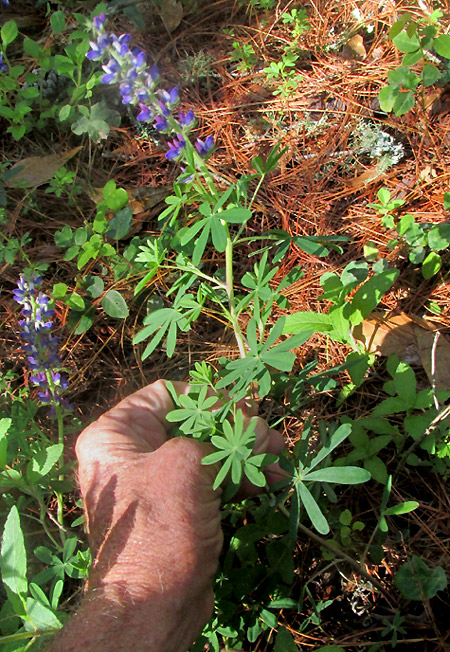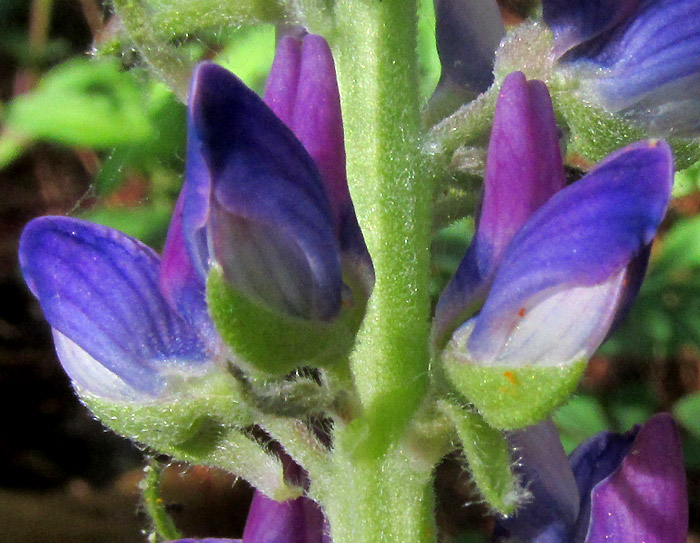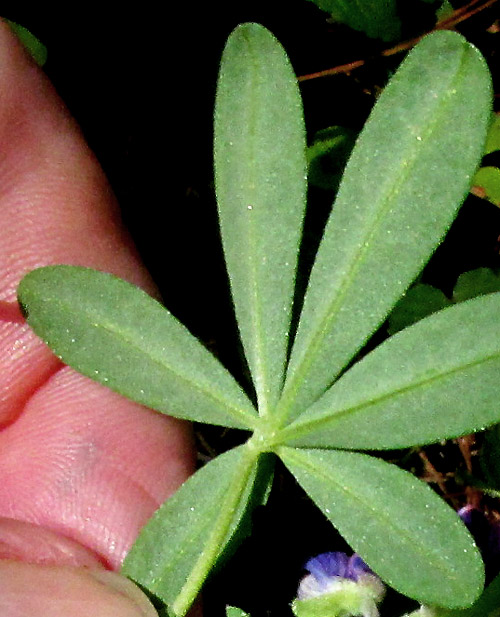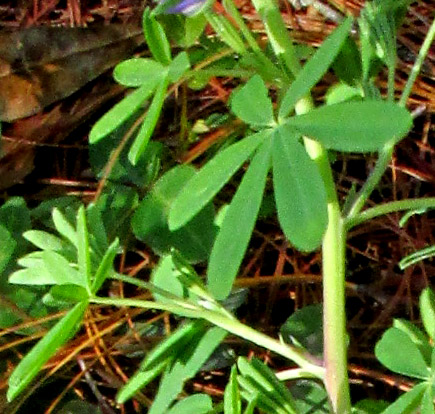Excerpts from Jim Conrad's
Naturalist Newsletter
Entry from field notes dated September 3, 2023, taken in Los Mármoles National Park in the Eastern Sierra Madre mountains, Hidalgo state, MÉXICO; oak-pine forested mountain peak about 3km west of Puerto de Piedra, on road branched off the road between Trancas {on maps designated "Morelos (Trancas)"} and Nicolás Flores; limestone bedrock; elevation ~2,650m (~8,700ft); N20.816°, W99.214°
LUPINUS VERSICOLOR SWEET

In a borderline cloud forest of pines and oaks, the above plant belongs to one of the easiest to recognize groups of wildflowers. With such compound leaves with several slender leaflets radiating from a single point atop a petiole like fingers from the palm of a hand, and the raceme-type, plant-top inflorescence of fair-sized flowers which are strongly bilaterally symmetrical like bean flowers in a garden, it's a lupine, genus Lupinus of the huge Bean Family, the Fabaceae.

The above close-up shows the flowers' basic papilionaceous structure: Of the flower's five petals, the top one, the standard, rises above the others, while on both sides of the flower there are separate petals called wings, and the remaining two lower petals are fused along their common margin, forming a scoop-shaped keel, like the keel of a boat.

At the right a closer look at the inflorescence is provided because it shows something noteworthy. Midway up the inflorescence, the flowers' top petals, the standards, are white, while the lower petals, the keels, are blue. Toward the inflorescence's bottom, it's the opposite, with flowers producing blue standards and white keels. The above flowers with their blue standards and white keels occupied a position near the bottom.
Many or most lupine species produce more leaflets than ours, which usually number 6-8, plus most species' leaflet tips are more pointed, often sharply. Here's a closer look at ours:

Another distinctive feature of this species is that on the upper half of the stem, side branches arise from the axils formed between the stem and petioles:

Lupines as a group are easy to recognize, but where numerous lupine species occur, often distinctions between them are so subtle that they're hard to identify to species level. About 200 Lupinus species currently are recognized worldwide and Mexico is a center of species diversity for them. The 2021 study by José Luis Villaseñor and others entitled "Riqueza y distribución de la flora vascular del estado de Hidalgo, México" lists thirteen Lupinus species documented for our upland central Mexican state of Hidalgo.
Especially our plant's relatively few 6-8 leaflets, and the leaflets' tips being somewhat rounded or at least not definitely sharply pointed, are good field marks for the species. Also, it's helpful to notice that the flowers' standards when seen from the front are quite narrow, though from the side it's seen that the standards' sides extend backwards, dropping out of view from the front. All the above features, plus the plant's occurrence in high-elevation oak-pine forest lead us to LUPINUS VERSICOLOR Sweet.
The "Sweet" part stuck onto the name is being used because at least three authors have published the name Lupinus versicolor, and that can be confusing if we don't do what's normally done in truly technical literature, which is to append the name of the author who published it after the binomial, or scientific name. The author's name is not italicized. Thus our plant is "Lupinus versicolor Sweet," plus there are the other published names of "Lupinus versicolor Caball." and "Lupinus versicolor Lindl." The Sweet in our plant's name refers to Robert Sweet, an English botanist, who published our plant's name in 1823.
The naming issue is further confused by Lupinus versicolor Lindl. being the former name of a popular wildflower in coastal California. That plant now is named Lupinus variicolor, but older literature still uses Lupinus versicolor. Even worse, the California plant is very similar to ours, except for its habitat requirement.
Lupinus versicolor Sweet is narrowly endemic, occurring only in parts of three or four states in highland central Mexico, Hidalgo state being one of them.
Probably because our plant is such a narrow endemic and occurs in such a special highland habitat, I find no literature of humans using it, though of course Nature has Her many ways of finding our plant's existence agreeable.